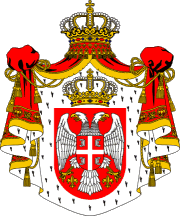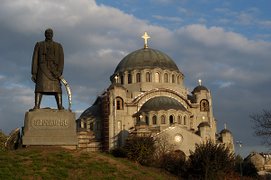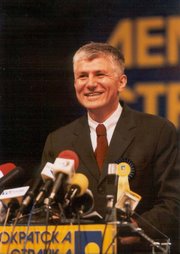
Cropped famous photograph "Raising the Flag on Iwo Jima" taken by Associated Press photographer Joe Rosenthal who photographed five Marines and a U.S. Navy corpsman raising the U.S. flag atop the 166 meter (546 ft) Mount Suribachi.
The photo is actually of the second flag to be raised on the mountain. The first flag was taken as a souvenir by a high ranking Navy Officer James Forrestal. The picture became the iconic image of the battle, and the most reproduced photograph of all time.
[There are six Flag Raisers: the front four are (left to right) Ira Hayes, Franklin Sousley, John Bradley and Harlon Block, and the back two are Michael Strank (behind Sousley) and Rene Gagnon (behind Bradley).
=> Mike Strank (born: 1919 Jarabenia, Czechoslovakia. died: 1945 Iwo Jima, Japan.)
=> Harlon Block (born: 1924 Yorktown, Texas. died: 1945 Iwo Jima, Japan.)
=> Franklin Sousley (born: Sept. 19, 1925 Hilltop, KY. died:March 21, 1945 Iwo Jima, Japan.)
=> Ira Hayes (born: Jan. 12, 1923 Sacaton, Arizona died: Jan. 24, 1955 Bapchule, Arizona)
=> Rene Gagnon (born: Manchester, N.H. March 7, 1925 died: Manchester, N.H. Oct. 12, 1979)
=> John Bradley (born: July 10, 1923 Antigo, WI. died: January 11, 1994 Antigo, WI.)
John Bradley, a quiet, private man, gave just one interview in his life. In it he said . . . "People refer to us as heroes-I personally don't look at it that way. I just think that I happened to be at a certain place at a certain time and anybody on that island could have been in there--and we certainly weren't heroes--and I speak for the rest of them as well. That's the way they think of themselves also". He avoided discussion of his war record saying only that the real heros were the men who gave their lives for their country.
The Global Media reported the death of a World War II icon on January 11, 1994 at the age of 70. But his hometown newspaper best captured the essence of Bradley's life after the war:
"John Bradley will be forever memorialized for a few moments action at the top of a remote Pacific mountain. We prefer to remember him for his life. If the famous flag-raising at Iwo Jima symbolized American patriotism and valor, Bradley's quiet, modest nature and philanthropic efforts shine as an example of the best of small town American values." - Editorial 'The Antigo Daily Journal'
Ira Hayes was a Pima Indian. When he enlisted in the Marine Corps, he had hardly ever been off the Reservation. His Chief told him to be an "Honorable Warrior" and bring honor upon his family. Ira was a dedicated Marine. Quiet and steady, he was admired by his fellow Marines who fought alongside him in three Pacific battles.
When Ira learned that President Roosevelt wanted him and the other survivors to come back to the US to raise money on the 7th Bond Tour, he was horrified. To Ira, the heroes of Iwo Jima, those deserving honor, were his "good buddies" who died there.
At the White House, President Truman told Ira, "You are an American hero." But Ira didn't feel pride. As he later lamented, "How could I feel like a hero when only five men in my platoon of 45 survived, when only 27 men in my company of 250 managed to escape death or injury?" Ira tried to drown his "Conflict of Honor" with alcohol. "I was sick. I guess I was about to crack up thinking about all my good buddies. They were better men than me and they're not coming back. Much less back to the White House, like me."
In 1954, Ira reluctantly attended the dedication of the Iwo Jima monument in Washington. After a ceremony where he was lauded by President Eisenhower as a hero once again, a reporter rushed up to Ira and asked him, "How do you like the pomp & circumstances?" Ira just hung his head and said, "I don't."
Ground fighting on the island took place over approximately 35 days, lasting from the landings of February 19th to a final Japanese charge the morning of March 26, 1945.
At 02:00 on February 19, battleship guns signaled the commencement of the invasion of Iwo Jima.
Soon 100 bombers attacked the island, followed by another volley from the naval guns. Although the bombing was consistent, it did not deter the Japanese defenses, as most of the Japanese positions were very well fortified and protected from shelling.
At 08:59, one minute ahead of schedule, the first of an eventual 30,000 Marines landed on the Japanese island of Iwo Jima.
The initial wave was not hit by Japanese fire for quite some time, as it was the plan of Japanese General Kuribayashi to hold fire until the beach was full of American marines. Only after the front wave of Marines reached a line of Japanese bunkers defended by machine gunners did they take hostile fire.
Aside from the Japanese defenses situated on the actual "beaches", the Marines faced heavy fire from Mount Suribachi at the south of the island.
It was extremely difficult for the Marines to advance due to the inhospitable terrain, which consisted of volcanic ash.
Yard by yard, the Marines advanced while taking heavy firearm and artillery fire. Thanks to the arrival of armored units and heavy naval artillery and air units shelling Suribachi, the Marines were eventually able to advance past the beaches.
By that evening the mountain had been surrounded and 30,000 Marines had landed. About 40,000 more would follow.
In the days after the landings, the Marines expected a banzai attack during the night. This had been the standard Japanese defense strategy in previous battles against enemy ground forces in the Pacific, during which the majority of the Japanese attackers would be killed and the Japanese strength greatly reduced. However Kuribayashi had strictly forbidden any banzai charges as he knew the futility of it.
By the morning of the fourth day of the battle, Mount Suribachi was effectively cut off from the rest of the island—above ground. By that point, the Marines knew that the Japanese defenders had an extensive network of below-ground defenses, and knew that in spite of its isolation above ground, the volcano was still connected to Japanese defenders via the tunnel network. They expected a fierce fight for the summit.
Two four-man patrols were sent up the volcano to reconnoiter routes on the mountain's north face. Popular legend has it that the Marines fought tooth and nail all the way up to the summit. But although the riflemen were tensed for an ambush, none materialized. The riflemen did encounter small groups of Japanese defenders on Suribachi, but the majority of the Japanese troops stayed underground in the tunnel network. They attacked in small numbers, but all attackers were killed. They made it to the summit and scrambled down again, reporting the lack of enemy contact to Colonel Chandler Johnson.
Johnson then called for a platoon of Marines to climb Suribachi. With them, he sent a small American flag to fly if they reached the summit. Again, Marines began the ascent, expecting to be ambushed at any moment. And again, the Marines reached the top of Suribachi without incident. Using a length of pipe they found among the wreckage atop the mountain, the Marines hoisted the U.S flag over Mount Suribachi, the first foreign flag to fly on Japanese soil in centuries.
Despite the loss of Mt. Suribachi, the Japanese still held a strong position.
The struggle to take the Motoyama Plateau, including "Turkey Knob" was to take the better part of three weeks.
The fighting was extremely fierce.
Japanese troops would occasionally spring out of tunnels and ambush the Marines. However, the situation heavily favored American victory despite the Japanese advantage of superior firepower.
The Marines learned that firearms were relatively ineffective against the Japanese defenders and learned to effectively use flamethrowers and grenades to flush out Japanese troops in the tunnels. One of the technological innovations of the battle, the 8 Sherman M4A3R3 medium tanks equipped with the Navy Mark I flame thrower proved very effective at clearing the Japanese positions. Illumination rounds (flares) which were used to light up the battlefield at night were initially provided by ships, shifting over later to landing force artillery. Navajo code talkers were part of the American ground communications, along with walkie-talkies and SCR-610 backpack radio sets.
Most Japanese soldiers fought to the death.
On the night of 25 March, a 300-man Japanese force launched a final counterattack in the vicinity of Airfield Number 2. Army pilots, Seabees and Marines of the 5th Pioneer Battalion and 28th Marines fought the Japanese force until morning but suffered heavy casualties—more than 100 killed and another 200 American wounded. The island was officially declared "secured" the following day.
Although still a matter of speculation due to conflicting accounts from surviving Japanese veterans, it has been said that Kuribayashi himself led this final assault. If ever proven true, Kuribayashi will have been the highest ranking Japanese officer to ever personally lead an attack during World War II.
Of the over 22,000 Japanese soldiers, 20,703 died and 216 were captured. The Allied forces suffered 27,909 casualties, with 6,825 killed in action. As all the civilians had been evacuated, there was not one single civilian casualty at Iwo Jima.
 " The life of your father is just like a lamp before the wind." - Lieutenant General Tadamichi Kuribayashi, in a letter to his son.
" The life of your father is just like a lamp before the wind." - Lieutenant General Tadamichi Kuribayashi, in a letter to his son.





